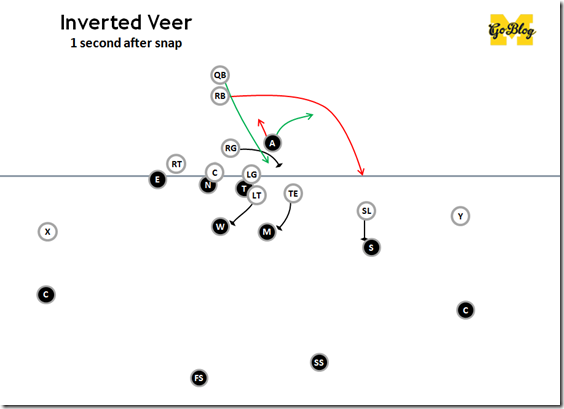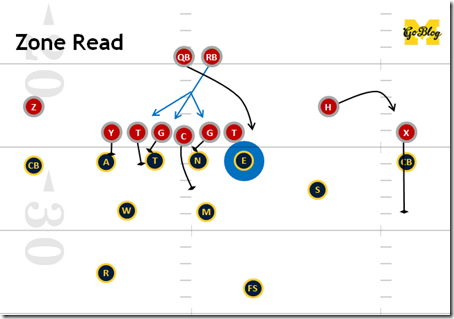defending the option

9/7/2019 – Michigan 24, Army 21 (2OT) – 2-0
Welcome, BPONE sufferers! A double-overtime game against Army has everyone back in the pit, and even in the cold light of day 48 hours later it's hard to argue. A week after it felt like Michigan had added a bunch to the arc read package that saved their running game last year, Michigan QBs kept once and Zach Charbonnet trundled towards a very 1982 line: 33 carries, 100 yards.
Back in 1995 the shotgun was understood as an offensive gambit limited to passing downs because attempting to run out of it sucked. It would continue to suck until Rich Rodriguez accidentally invented the zone read when his QB at Glenville State screwed up. Once the option made spreading the field a run-game advantage instead of a disadvantage… [gestures at college football].
Michigan took the portal back to 1995 this weekend, and now we're back to crabbing about Michigan's offensive system while Lloyd Carr's on the field. RIP Speed In Space, 8/31/2019-9/7/2019. Cue the spittle, and the condescending media columns about how spittle is unbecoming.
---------------------------------------
In the aftermath Harbaugh was asked about the lack of reads from his quarterback and made some assertions that I hope are not true:
On Shea Patterson potentially being dinged up and not running on option plays
He ran a couple. He was better. He was able to work through what he had and felt 100 percent for the game.
The read was not there for the quarterback to pull it.
If this is a 100% Shea Patterson, Michigan isn't doing anything this year. And it probably isn't. Patterson's lone called run of the game went four yards; Patterson was not hit but dove forward onto the ground. There he stayed. Dylan McCaffrey came in for the next two plays. Patterson returned for OT, hitting a couple of short throws across the middle in Michigan's first drive before three consecutive bad misses in OT2.
That certainly feels like a QB who Michigan is attempting to protect, because as soon as they stop doing that he goes out of the game briefly and then airmails all his passes of any length. (The OT1 throws were inside the hashes; the OT2 throws were on the sideline.)
The frustrating thing is that Army's approach never got tested. Michigan's rock paper scissors wins in this game were close to nonexistent. Army swallowed a fourth and two play with two guys in the backfield. Patterson's lone zone read keep ate a corner blitz. Michigan ran out of ideas late and kept returning to a no-read power play. This wasn't a return to the sometimes clunky early Harbaugh days—those had tons of different run plays and regularly popped guys through big holes by misdirecting linebackers. This was a near-total abdication of the idea of coordinating a run game.
So, like, what the hell? Why did game two of Josh Gattis become a debacle on par with Let's Put Denard Under Center? If Patterson is hurt why isn't Dylan McCaffrey playing? If Army is messing with Michigan's reads in basic scrape exchange ways, why don't you have a plan for that?
Like the title says: no good answers.
There's a lot of people extrapolating from not enough data and deciding to jump out of a plane; it's too early for that, but getting approximately zero coordinator wins in a tight game against Army while both quarterbacks get their offseason hype blown up is cause for concern.
Football's weird and Michigan has a bye week to get healthy and figure some things out. They'll have to.
[After THE JUMP: slomka, slomka, slomka, egg, and slomka]
Okay so I’ve talked about this before. Maybe more than once. But Ohio State loves this play, so much that its variations account for 3 of the first 4 plays on Curtis Samuel’s Oklahoma highlight reel (and 2 more are counters off it).
Inverted Veer (again)
This play is called “Inverted Veer” or “Power Read.” It was the staple of the Borges-Denard/Devin fusion cuisine era, because it is the mullet of offensive plays: manball business in the front, spread party in the backfield.
Here’s a basic setup:
The offensive line is blocking like power C: block down and pull from the backside, and cave the frontside.
A second after the snap reveals why it’s such a devastating play:
While a good ol’fashioned zone-read might option a backside defender, inverted veer options the playside end man on the line of scrimmage (EMLOS). That defender is allowed into the backfield and optioned: if he comes up too far, the ball is given to the running back, who accelerates away to the outside—You’ve been EDGED! If the end gets wide to prevent the running back from getting the edge, that opens up room for the quarterback to dive into the gap behind him—You’ve been GASHED!
[Hit THE JUMP for variations, and how Michigan defended this]
Everyone's got their recruit they're over-excited about, but I've fallen hard for the first Don Brown potential dude, Joshua Uche. I figure I should explain why.
So we all remember this, right?
This is now run 100 different ways, with all sorts of guys to read and all sorts of places to attack. The idea is usually the same: leave an edge defender unblocked and read him off while the QB is holding the ball in the RB's breadbasket. It's "zone" because you're watching that blue circle, not the guy in it, since defenses will screw with you otherwise by having the end dive in and a linebacker appear or something. It's "read" because once you've ID'ed the unblocked defender, you watch to see if he's going to take the RB or the QB, then make him wrong.
Now that it's approaching 30 years old, defenses have had a long time to adjust to it. But like the option, or Power, or the Veer, or west coast passing route combinations, it's a good enough base play to remain a standard feature in most college offenses. That means every college team has to spend practice time learning multiple methods to stop it, and probably will as long as the sport lasts.
Don Brown's BC playbook was no exception, devoting over a tenth of the document to beating spread things. Today I'd like to introduce Brown's particular version of zone read defense, then zoom in on the vanilla zone read stopper play and what it means for the kind of player he wants at "End", i.e. the weakside defensive end. I don't want to get into all of the run fits and stuff, but since we just ran Josh Uche's recruiting profile I thought it would be cool to go over exactly what he was recruited to do.
ZONE READ STOPPERS
Every coach has his own tweaks, but strategies for defending the mesh (that handoff decision) usually follow along a few similar ideas:
1. Delay the mesh for so long that the rest of the defense can react, beat their blocks, and corral the ballcarrier.
- Pros: Doesn't use an extra defender/vanilla response.
- Cons: Hard to do, requires the rest of the defense to win blocks, extra time for play develop can also work against you.
2. Scrape exchange. Attack one or the other to force a fast decision and bring another defender (usually from somewhere he's not expected) to bring down the other guy.
- Pros: The paper to this particular rock.
- Cons: You're using two defenders, opening up scissors.
3. Blow it up. Send that unblocked guy right at the mesh point itself.
- Pros: Aggressive. Against college quarterbacks this may trigger all sorts of bad reactions. May give you a few extra opportunities to hit the quarterback.
- Cons: A good ZR team will calmly hand it off.
A lot of teams will have one they feature more than the others, depending on the abilities of their personnel and what kind of team they're facing that week. Like, if you're more worried about the QB running than throwing you may scrape them all day. If you're facing a true freshman 3rd stringer they just ripped the redshirt off of maybe blow it up. If the zone read is just a sideshow and the real threat is the RB you may go in with just the delay. If you're facing a team that uses the zone read as a big part of its offense you really ought to have all three, and different variations of them perhaps, so the offense won't know what's coming.
Of these, the delay is good ol' rock-on-rock.*
[After the JUMP: why Uche looks like he will excel at rock]



214